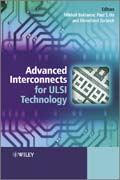
Advanced interconnects for ULSI technology
Baklanov, Mikhail
Ho, Paul S.
Zschech, Ehrenfried
INDICE: About the Editors xv List of Contributors xvii Preface xxi List of Abbreviations xxv Section I Low-k Materials 1 1 Low-k Materials: Recent Advances 3 Geraud Dubois and Willi Volksen 1.1 Introduction 3 1.2 Integration Challenges 5 1.2.1 Process-Induced Damage 6 1.2.2 Mechanical Properties 9 1.3 Processing Approaches to Existing Integration Issues 10 1.3.1 Post-deposition Treatments 11 1.3.2 Prevention or Repair of Plasma-Induced Processing Damage 14 1.3.3 Multilayer Structures 15 1.4 Material Advances to Overcome Current Limitations 16 1.4.1 Silica Zeolites 16 1.4.2 Hybrid OrganicInorganic: Oxycarbosilanes 19 1.5 Conclusion 22 References 23 2 Ultra-Low-k by CVD: Deposition and Curing35 Vincent Jousseaume, Aziz Zenasni, Olivier Gourhant, Laurent Favennec and Mikhail R. Baklanov 2.1 Introduction 35 2.2 Porogen Approach by PECVD 37 2.2.1 Precursors and Deposition Conditions 37 2.2.2 Mystery Still Unsolved: From Porogens to Pores 41 2.3 UV Curing 42 2.3.1 General Overview of Curing 42 2.3.2 UV Curing Mechanisms 43 2.4 Impact of Curing on Structure and Physical Properties: Benefits of UV Curing 49 2.4.1 Porosity 49 2.4.2 Chemical Structure and Mechanical Properties 50 2.4.3 Electrical Properties 56 2.5 Limit/Issues with the Porogen Approach 57 2.5.1 Porosity Creation Limit 58 2.5.2 Porogen Residues 59 2.6 Future of CVD Low-k 62 2.6.1 New Matrix Precursor 62 2.6.2 Other Deposition Strategies 64 2.6.3 New Deposition Techniques 66 2.7 Material Engineering: Adaptation to Integration Schemes 68 2.8 Conclusion 70 References 71 3 Plasma Processing of Low-k Dielectrics 79 Hualing Shi, Denis Shamiryan, Jean-Francois de Marneffe, Huai Huang, Paul S. Ho and Mikhail R. Baklanov 3.1 Introduction 79 3.2 Materials and Equipment 80 3.3 Process Results Characterization 82 3.4 Interaction of Low-k Dielectrics with Plasma 85 3.4.1 Low-k Etch Chemistries85 3.4.2 Patterning Strategies and Masking Materials 87 3.4.3 Etch Mechanisms88 3.5 Mechanisms of Plasma Damage 92 3.5.1 Gap Structure Studies 93 3.5.2 Effect of Radical Density 95 3.5.3 Effect of Ion Energy 96 3.5.4 Effect of Photon Energy and Intensity 99 3.5.5 Plasma Damage by Oxidative Radicals 103 3.5.6 Hydrogen-Based Plasma 105 3.5.7 Minimization of Plasma Damage 108 Optimizationof Porous Low-k Dielectrics 108 Choice of the Plasma Reactor 109 Choice of the Plasma Species 109 Optimizing Process Integration: Porogen Removal and He Pre-treatment 109 3.6 Dielectric Recovery 112 3.6.1 CH4 Beam Treatment 112 3.6.2Dielectric Recovery by Silylation 113 Choice of Silylation Agents 116 Silylation Process Condition and Medium 119 3.6.3 UV Radiation 119 3.7 Conclusions 121 References 122 4 Wet Clean Applications in Porous Low-k Patterning Processes129 Quoc Toan Le, Guy Vereecke, Herbert Struyf, Els Kesters and Mikhail R. Baklanov 4.1 Introduction 129 4.2 Silica and Porous Hybrid Dielectric Materials 130 4.3 Impact of Plasma and Subsequent Wet Clean Processes on the Stability of Porous Low-k Dielectrics 134 4.3.1 Stability
- ISBN: 978-0-470-66254-0
- Editorial: John Wiley & Sons
- Encuadernacion: Cartoné
- Páginas: 624
- Fecha Publicación: 09/03/2012
- Nº Volúmenes: 1
- Idioma: Inglés
